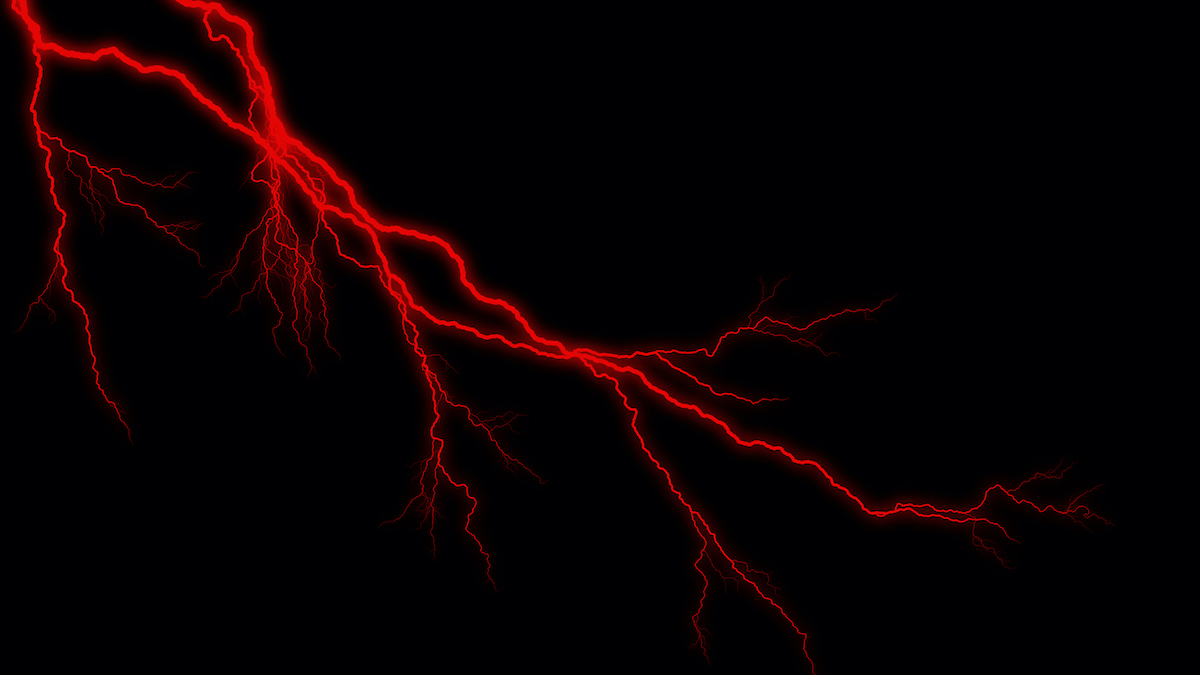What Is Red Lightning? The Impressive, Elusive Phenomenon, Explained

Red lightning? What kind of Dark Side of the Force horror show is this? Have the Sith Lords unlocked this power yet? George Lucas, explain yourself. What did you do to the sky?
Red lightning … Mother Nature’s villain power
I hate to break it to you, but so far we’ve never seen red lightning in the most cracking-through-the-sky lightning-looking sense. It’s not like those big, jagged streaks of electricity that strike the earth in thunderstorms are somehow dyed crimson. (Yes, that photo above is a lie.)
Red lightning happens in short, weird little bursts. It appears and disappears suddenly, like a magical goblin! That’s why red lightning bolts are known as “sprites.” And they’re not really “bolts” at all. More like little red electric splashes. Still cool though.
So where do they come from?
Sprites comes from severe thunderstorms. When a regular (boring AF) bolt of lightning flashes, a totally sick red sprite shoots out the top of the thundercloud and into the upper atmosphere! Scientists have difficulty studying these shy little guys, because they only appear for a few milliseconds.
It turns out that “SPRITE” is actually an acronym. Scientists LOVE acronyms. It stands for Stratospheric Perturbations Resulting from Intense Thunderstorm Electrification. Like regular lightning, Sprites are a result of electric charges built up in the upper atmosphere. Unlike regular lightning, which is totally unoriginal and just releases its charge on the boring ground, RED lightning releases in the ionosphere—wicked.
Sprites are also WAY BIGGER than regular lightning and can be as large at 30 miles across. Sprites are red because of the way they excite molecular nitrogen in the atmosphere. They appear red at their apex and slightly bluer the closer they get to the surface of the earth.
Sprites come in three basic shapes: jellyfish, carrot, and column. Jellyfish sprites are the biggest and look like cool spooky red night jellyfish that light up the sky. Carrot spites look like … carrots. Column sprites … you get the idea. Tragically, Sprites are really hard to see from the ground, considering they happen above cloud level. In order to see a Sprite, a ground observer must have optimal optical conditions. A faraway thunderstorm with regular lightning, red-sensitive equipment, and a sky untouched by pesky light pollution. Only then will an elusive Sprite emerge from atmospheric hiding.
A Brief History of Sprites
The earliest known report of a sprite is from 1886. They were later theorized to exist by Charles Thomson Rees Wilson, a scientist and Nobel prize laureate.
Sprites were first captured on video on July 6, 1989 by Dr. John Winckler and associates at the University of Minnesota. Like pretty much everything else in science, they were discovered by accident. The team were testing out optical sensors intended for rocket ships, and the good doctor was recording a video of the stars and a distant thunderstorm. After a flash of lightning, a sprite was captured on the monitor. Sprites were later confirmed to exist after NASA observed them while conducting observational experiments with space shuttle equipment.
Despite the whimsical nature of sprites, they’ve been blamed for high-altitude aircraft accidents. Why? Because scientists can’t explain what went wrong any other way. Pretty scapegoaty if you ask me. In 1980, NASA launched a weather balloon over Texas that suddenly malfunctioned during a thunderstorm. Scientists were baffled, because the balloon was flying above the storm, and should have been safe from lightning strikes. As it turns out, it WAS safe for regular old lightning strikes, but not from super cool (and kinda dangerous) sprites!
Transient luminous events: The sprite’s cousins!
Sprites are actually part of a whole incestuous family of electrical phenomena! There are blue jets, which are exactly what they sound like, jets of blue light that explode from the top of a thundercloud. There are elves, which are super cool halos of light that appear in the uppermost layer of the atmosphere, stretching out in a 300-mile circle. There are trolls, which resemble blue jets but are red in color (sprite posers). There are gnomes, which are also similar to blue jets but are brighter and smaller. And there are even pixies! Pinpoints of light on gnome-producing clouds that last for only a few milliseconds. Mother Nature herself is writing an A Court of Thorns and Roses-type fairy fanfic in real life!
(featured image: blackie/Getty Images)
Have a tip we should know? tips@themarysue.com